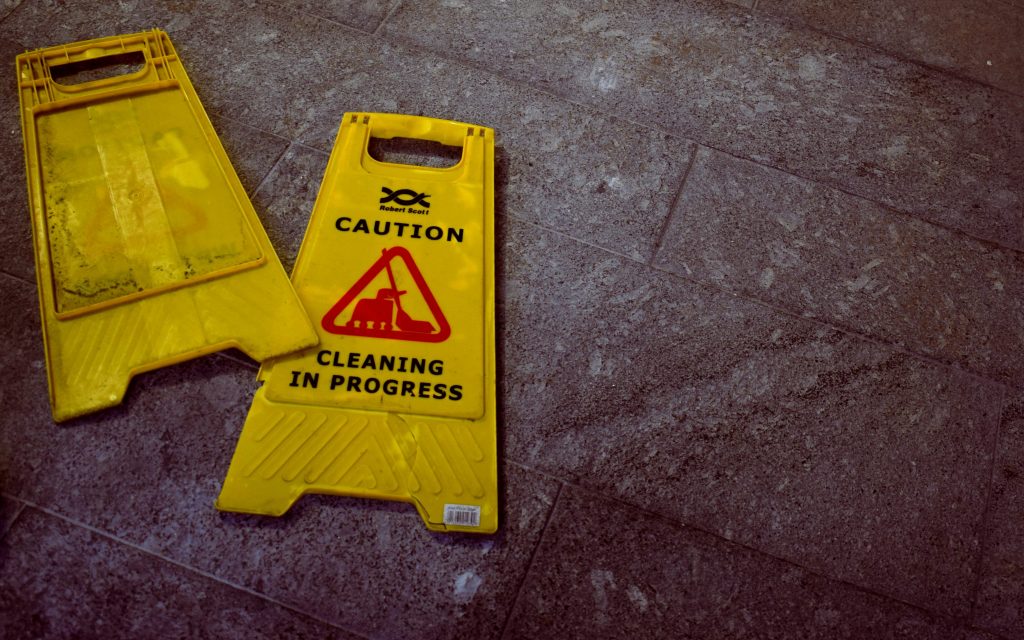SMC Premier surveyed over 5,000 UK hybrid office workers in 2022 to uncover the dirty truth about their work habits and cleanliness. Be warned; the results can make you feel queasy and uncomfortable, so you may want to shower after.
A study by the University of Arizona found that germs are passed on by the spread of precipitations of infected individuals via sneezing or coughing, as well through touching surfaces. Once the bacteria’s reach the surface, they can persevere for hours, even months and spread to uninfected individuals through the contaminated surfaces and infection sites such as the nose, mouth or eyes*.

You may want to think twice before shaking a client’s hand or having contact with a colleague at work, as the survey revealed that just 61% of office employees wash their hands properly with warm water and soap after a visit to the toilet. So, what about the rest of them? 18% wash their hands quickly; 14% decide when to wash their hands after going to the bathroom, leaving a sickening 7% who admitted to not washing their hands.
Interestingly, the results also revealed that women are slightly more hygienic after using the toilet, as 66% said they wash their hands thoroughly compared to 53% of men.
When comparing the age groups, 11% of the younger generation (18-24-year olds) confessed to not washing their hands after the toilet, making this statistic above the overall average of 7%. Fortunately, the older generation 45+ make sure their hands are clean with (68%).
While the thought of having a pet in the office is cute and can boost morale amongst employees, not everyone feels the same. 77% of those asked actively believe having an office dog to stroke is unhygienic and the over 65’s feel more strongly about this than anyone with a staggering 85% sharing the same feelings.
There are still dog office lovers amongst the UK public with 16% loving the idea of having an office pet, especially the 18-24-year olds, as 26% think have a furry four-legged friend running around is a fantastic idea.
4% of those who have a dog in the office love it, sadly, 2% have considered leaving because of it, and 1% are allergic.

Busy working days can result in office workers eating at their desk and working through lunches, and for 26% of respondents, eating at their desk happens at least 1-3 times per week. ¼ of office workers will eat while working 3-5 days per week, leaving what might seem a small percentage of 4% who have no choice but to enjoy their snacks and lunch every day sat at their desk.
However, 50% of those asked refused to sit at their desk to enjoy a sandwich or a warm bowl of soup.
On average, around half of 18-64-year olds will move away from their desk to eat, leaving the other half to remain seated occasionally.
Has eating at your desk become the norm in today’s office culture? Or are employers expecting their staff to work through breaks and lunches to get work done?
Surprisingly, only 11% will clean their desk properly after eating there, but, a significant 38% will do a ‘quick clean’ i.e. put snack wrappers in the bin. But where does that leave everyone else?
Well, 45% claim never to spill a crumb on their desk, leaving 7% who are too lazy to care and refuse to clean up after themselves.
It turns out the older generation of over 65-year olds are cautious about making a mess after eating at their desk with 72% claiming that they don’t need to clean up, compared to just 1/3 of Millennials.
Hot desking has grown in popularity in the post-pandemic era, especially amongst the self-employed and freelancers who need an office vibe for a change in environment, or client meeting. But is hot desking hygienic?
We asked the UK public about their thoughts around hot desking, and how often they assumed business premises owners were cleaning their offices or primary locations. Shockingly, only 6% of those surveyed assume that communal desks get cleaned after use.
12% who hot desk is fussy about where they work and will only work on the desk if they know it’s been cleaned first. Whereas, 38% believe hot desking to be unhygienic, as you never know who’s been sat there. 44% had never considered the possibility that hot-desking can be unclean.

Or should it? Can you honestly say that if you saw a tea spillage on the surface or rubbish on the floor that you would leave for the cleaner to sort out at the end of the day? For 6%, they would because it’s not their problem and wouldn’t think twice about leaving it to someone to else.
Fortunately, not all hope is lost, as 56% would clean up a mess if they saw it because it would annoy them, and nobody wants to work with a furious colleague. With that said, 38% confessed that they would reluctantly clean up if they really had to.
Although the average sits around 40% for the age groups who would clean someone’s else’s mess if they had to, it was higher amongst the 18-24-year olds with 51%.
We Britons are famous for sharing a cup of humble tea to make situations, and yourself feel better, but not if your mug has been left unwashed, or if your brew was made by a respondent who confessed to not washing their hands after going to the toilet!
Not all is lost in the office environment, as 39% will always make time to wash cups properly before making a brew round – lucky for some. 36% will do a quick rinse because they don’t want to use a communal sponge, which is a fair point. However, 25% just can’t be bothered and would prefer to make a fresh brew straight into the cup.
Next time you’re drinking a warm cup of tea or coffee at work, think about the cleanliness of your cup before taking a sip out of it, and more importantly, make sure the person who made you your brew washed their hands after a visit to the loo.
There is also another side, unfortunately; it’s not all puppies and spilt crumbs – there is the more serious side to workplace hygiene, which we take a look at in a bit more detail here. Read on if you want some more sobering and serious reasons for keeping your workplace clean and safe!
From 2019 to 2020, in Great Britain there were a whopping 1.6 million who suffered from illness which was work related – a significant 5.3% of the 33 million working population! That combination of work-related illness and injury led to 38.8 million lost days of work. Of course, all of that came at a cost, but just how much will likely surprise you; from 2018 to 2019, it is estimated that illness and injury from the workplace cost around £16.2 billion!
As well as the wellbeing of workers, which is certainly the primary concern, another key takeaway from these statistics is the massive cost of workplace illness and injury. The short term financial benefits of ignoring health and safety issues clearly aren’t worth it in the long run; what you save just isn’t worth it, when you can be faced with lost productivity, hefty pay-outs, PR nightmares, and hiked insurance premiums.
Those statistics are so big that it’s hard to break them down, to consider the impact on actual lives that they signify.
Through the Labour Force Survey, from 2019 to 2020, 693,000 people were reported as having sustained an injury at work, with another 65,427 reported as injured through RIDDOR. Of course, these statistics are most probably on the lower estimate of the true number, but it’s very difficult to put a number on unreported injuries, because of the very fact that they’re not reported!
Not all of those injuries were minor either; from 2020 to 2021, 142 people were killed at work, and 2,369 people died from mesothelioma from historic exposure to asbestos. Keeping your workplace clean isn’t just about making sure that it smells nice, it’s about minimising exposure to potentially lethal chemicals and pathogens.
A clean workplace has become far more important during coronavirus, where workplace outbreaks have had devastating effects on both the health of workers and overall productivity, especially if the entire workforce then has to self-isolate for 14 days.
Workplace COVID-19 levels are far lower than they were at their peak in the week beginning 21st Feb 2021, when there were 830 COVID cases reported in the workplace; however, in the week beginning 8th Aug 2021, there were still 124 cases reported, showing that it is an omnipresent threat!
While the data outlined above is sobering, use it as a wakeup call to get your office into perfect condition, and keep it that way! At the end of the day, productivity aside, the health of your workers should be your main concern; if you take care of that, and provide them a safe and clean environment, the rest will fall into place.
(HSE 2022)
https://www.hse.gov.uk/statistics/
https://www.hse.gov.uk/statistics/coronavirus/index.htm
While the majority of UK office workers remain relatively hygienic, there is still a proportion who aren’t, and although we can’t answer why, we can help to promote office cleaning in general, alongside a greater level of cleanliness and appreciation for the importance of hygiene in the workplace.
A clean office can help prevent germs spreading, especially when work colleagues are unwell, as the spread of bacteria becomes more rapid. It’s also never been more important to address the spread of viruses with regular decontamination cleaning protocols.
Remember, studies have found that a viral infection can quickly spread amongst office environments through direct transmissions, i.e. inhaling droplets from sneezing, coughing, ingesting contaminated foods and drinks. Also, germs can spread via secondary transmissions such as contaminated surfaces and hand-to-mucous membrane contact**.
Hand hygiene gels are recommended to have around the office and should be encouraged to use on a regular basis. These types of commonly used cleaning product can also be purchased in bulk from sites such as Premier Hygiene amongst others, so there’s really no excuse for offices to not be stocked-up on basic hygiene essentials.
It takes a few seconds to wipe down the surface after lunch and to wash cups up before making a fresh brew, but a few seconds can make all the difference and turn your working environment into something more pleasant and germ-free.
Having a dog running around the office can boost most employee’s moral, but the adorable four-legged pet can be a little unhygienic if the cleanliness of the office isn’t maintained.
Hopefully, we haven’t put you off using shared items in the office, but we hope the survey findings have helped you think about the importance of having a clean working environment (including eating at your desk).
For information on mitigating the spread of coronavirus in your office or workplace please see the following advice from our staff.
*Kelly A. Reynolds, Paloma I. Beamer, Kevin R. Plotkin, Laura Y. Sifuentes, David W. Koenig & Charles P. Gerba (2015): The healthy workplace project: Reduced viral exposure in an office setting, Archives of Environmental & Occupational Health
**Paloma I. Beamer, Kevin R. Plotkin, Charles P. Gerba, Laura Y. Sifuentes, David W. Koenig & Kelly A. Reynolds: Modeling of Human Viruses on Hands and Risk of Infection in an Office Workplace Using Micro-Activity Data
SMC Premier legitimately surveyed 5,000 UK respondents using a UK based survey provider. SMC Premier Group are a team of facilities management service providers who also operate UK-wide with contracted services for school cleaning, retail spaces, industrial warehouses and even deep cleaning services.
 We use cookies on our website to give you the most relevant experience by remembering your preferences and repeat visits. By clicking “Accept”, you consent to the use of ALL the cookies.
We use cookies on our website to give you the most relevant experience by remembering your preferences and repeat visits. By clicking “Accept”, you consent to the use of ALL the cookies.